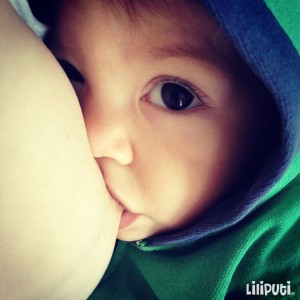Finally, you have managed to get rid off cultural pressure, and you realized the real needs of your baby. The first priority for your child is cuddling and breastfeeding, everything else is secondary. Babywearing is a perfect choice if you want to make sure that your baby gets enough cuddling and bodily contact every day. It is, in fact, beneficial for both mom and baby. Besides, close contact is a huge help in breastfeeding, as well.
 Nowadays, it is obvious that breastfeeding on demand is a biological norm. Diverging from it can trigger problems in the natural process: your baby may become restless, it can cause a decrease in your milk supply. Breastfeeding on demand means, that mother’s milk is not only assumed to be nourishment, but it is known to have a soothing and sedative effect as well. Besides, babies want their sucking need to be fulfilled even when they are not hungry. Infants may feed whenever they give a sign of their demand, irrespectively of the fact that the previous breastfeeding ended ten minutes ago or two hours ago. There is no typical daily routine, the family usually tunes into the baby’s needs, and parents learn his peculiar “mode of operation”, for example that he has a longer nap late morning almost every day, and feeds more often in the evening than during the day.
Nowadays, it is obvious that breastfeeding on demand is a biological norm. Diverging from it can trigger problems in the natural process: your baby may become restless, it can cause a decrease in your milk supply. Breastfeeding on demand means, that mother’s milk is not only assumed to be nourishment, but it is known to have a soothing and sedative effect as well. Besides, babies want their sucking need to be fulfilled even when they are not hungry. Infants may feed whenever they give a sign of their demand, irrespectively of the fact that the previous breastfeeding ended ten minutes ago or two hours ago. There is no typical daily routine, the family usually tunes into the baby’s needs, and parents learn his peculiar “mode of operation”, for example that he has a longer nap late morning almost every day, and feeds more often in the evening than during the day.
Skin-to-skin
There is a strong correlation between breastfeeding and mom-baby life. It can be detected by medical devices, that babies skin-to-skin with their mother after birth are in a better condition than newborns put into cribs. Their blood sugar level, temperature and breathing rates are more stable, their oxygen intake improves, and they sleep calmer. And maybe the most important regarding breastfeeding is that babies kept skin-to-skin with Kangaroo care accommodate to new circumstances more easily, they search for the breast more often, do not keep to themselves like babies kept in a crib. Frequent breastfeeding encourages good milk supply, and basically, it can be argued that it is the baby’s physiological need. It happens to carried babies very seldom that they feed only as rarely as every three-four hours, whilst babies in a crib are prone to sleep for such long hours.
Everything falls into place
Parents often complain about burping problems. I always explain them, that in earlier stages of evolution, babies were in fact burping for the whole day, since mothers kept them close to their body, in a vertical position: they were either sitting on their mother’s hip, or in a carrier on the waist, or on the back. Consequently, burping shouldn’t be separated from other events of daily life: if you wear the baby almost vertically, you are continually burping him – may this episode be an intimate relaxation in the armchair, cleaning with a stretchy wrap on, or a stroll outside. Even the shape of the stomach justifies this position. In fact, the stomach is a little sack with double curvature, and air can get stuck in its curves. If babies are put down after feeding, their tummy might hurt with the pressure from bubbles forming a big orb in their abdomen. If they are carried, the swinging movements of walking, and vertical position can help getting rid of the bubbles. Besides, warmth surrounding the belly has a soothing and pain-killing effect.
Solution for spit-ups
Reflux babies who often spit up also benefit from babywearing. The best for them is eating a little and often and burping up air they had swallowed very soon after feeding. If babies “live” in a sling, and they have access to the breast whenever they want to, they are unlikely to suck to bursting and spit up most of the milk. They will feed often and little.
Mothers with babies who spit up regularly should learn to tie the sling so that the baby can feed easily while being carried.


1 comment
add commentThat’s it! Absolutely agree, love this post!!!
Leave Comment
You must be logged in to post a comment.